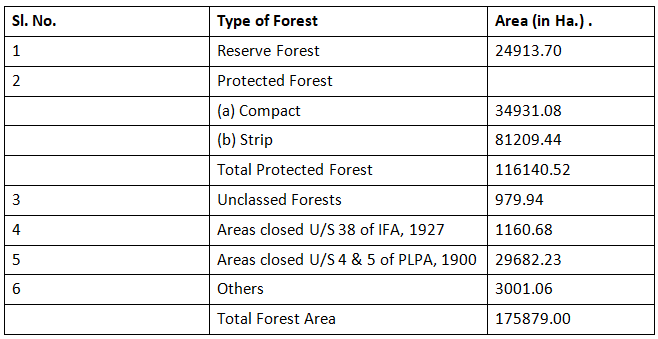Forest in Haryana | HPSC Preparation: All subjects - HPSC (Haryana) PDF Download
Forest
Haryana's forests are categorized as Reserve Forests, Protected Forests, Unclassed Forests, Areas closed under Section 38 of the Indian Forest Act, 1927, and Areas closed under Sections 4 & 5 of the Punjab Land Preservation Act, 1900. The Reserve Forest areas are primarily concentrated in the Shivalik ranges within Panchkula and Yamunanagar districts. Small blocks of Reserved Forests are distributed in various locations across Yamunanagar, Kaithal, Ambala, Jind, and Hisar districts. The majority of the state's forests fall under the Subtropical dry deciduous category, while subtropical thorny forests are exclusive to the Aravalli hills in the southern regions. Pine forests are situated at higher elevations within the Protected Forests of Morni Hills in Panchkula district, and Sal Forests predominate in the Reserve Forests of the Shiwaliks in Yamunanagar district.
To advance the sustainable development of forest resources within the state, the Haryana Government established its Forest Policy in 2006. The policy sets a target of attaining a 20% Forest and Tree Cover in the state through a phased approach. This objective can be realized by embracing Agroforestry practices, where genetically superior seedlings are utilized on farmlands to enhance productivity. Indeed, the nationwide adoption of Agroforestry should be encouraged as a people's movement, given its economic, sustainable, and steadfast nature, ensuring the ecological security of the country.
Up until the year 2012-2013, the Forest Department has been distributing approximately 2.5 crore seedlings to farmers at no cost. The Agroforestry plantations established by the Forest Department are regarded as among the finest in the country. Farmers have embraced Agroforestry as an Income Generation Activity, showcasing a model of rural development worthy of emulation throughout the country. The policy's approach of minimizing unnecessary restrictions on tree felling on private land and their subsequent transit has cultivated an environment that motivates a significant number of farmers to cultivate trees. The aim is to create a conducive environment where Agroforestry and Wood-Based Industries can prosper and expand concurrently.
Significant emphasis has been placed on Agroforestry and Farm Forestry, resulting in a substantial increase in the State's Tree Cover over the years. In fact, the Tree Cover outside the recorded forest area is nearly equivalent to the State's forested area. While the recorded forest area constitutes only 3.90% of the state's geographical expanse, the combined Forest and Tree Cover, according to the State of Forests Report, 2011, published by the Forest Survey of India, has expanded to 6.80%. Poplar tree plantations predominantly contribute to the Tree Cover in agricultural fields in Panchkula, Ambala, and Yamunanagar districts. Additionally, Eucalyptus, Shisham, Kikar, Jal, and Jand tree plantations in the agricultural fields of central and south Haryana significantly contribute to the overall Forest and Tree Cover in the State.
Forest Area of Haryana

Expanding the area under regular forests is challenging in the state of Haryana. Therefore, the department places significant emphasis on promoting Farm Forestry, Agroforestry, and afforestation of wasteland to enhance the Tree Cover.
Wildlife management holds special importance in Haryana due to a diverse range of bird species. The state encompasses approximately 33,000 hectares under the Protected Area Network, comprising 2 National Parks, 8 Wildlife Sanctuaries, and 2 Conservation Reserves. With over 500 recorded bird species, accounting for nearly 40 percent of the country's total, Haryana has the potential to be a haven for birdwatchers, particularly during the winter. Sultanpur National Park, located about 55 km from Delhi, is already renowned as a paradise for birdwatchers.
|
91 videos|318 docs|111 tests
|
FAQs on Forest in Haryana - HPSC Preparation: All subjects - HPSC (Haryana)
| 1. What is the forest area in Haryana? |  |
| 2. How is the forest area of Haryana managed? |  |
| 3. What are the environmental benefits of the forest area in Haryana? |  |
| 4. How can individuals contribute to the conservation of the forest area in Haryana? |  |
| 5. What measures are taken to prevent illegal activities in the forest area of Haryana? |  |




















